Place of origin Korea | ||
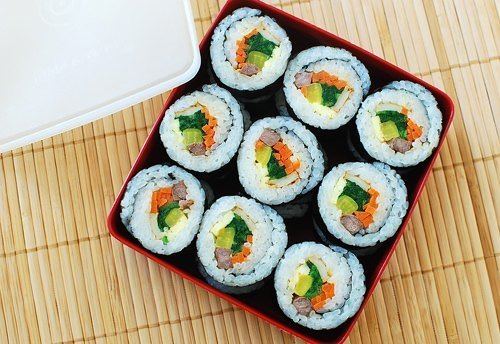 | ||
Similar Tteok‑bokki, Bibimbap, Kimchi, Bulgogi, Mandu | ||
Kimbap aka gimbap korean dish recipe
Gimbap (김밥) is a Korean dish made from cooked rice and various other ingredients rolled in gim (dried sheets of laver seaweed) and served in bite bite-size slices. Gimbap is often eaten during picnics or outdoor events, or as a light lunch, served with danmuji and kimchi. It is also a popular take-out food in Korea and abroad.
Contents
- Kimbap aka gimbap korean dish recipe
- How to make gimbap aka kimbap
- Etymology
- History
- Ingredients
- Variants
- Restaurant franchises
- References
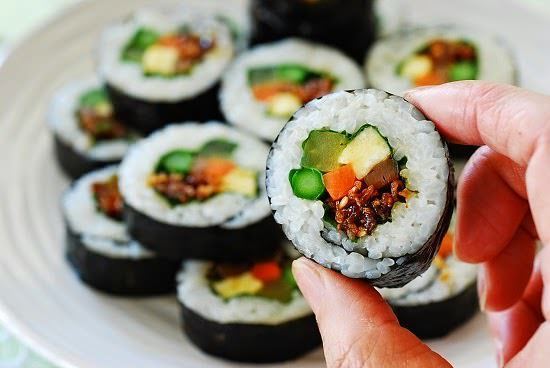
How to make gimbap aka kimbap
Etymology
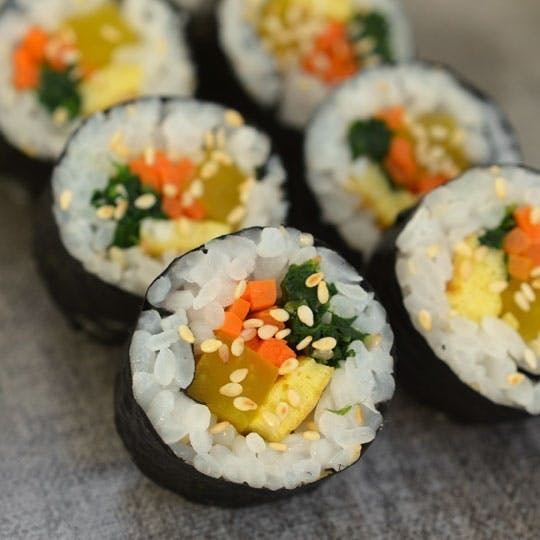
The word gim (김) refers to edible seaweed in the genus Porphyra. The word bap (밥) refers to "cooked grains", without qualifiers usually "cooked rice".
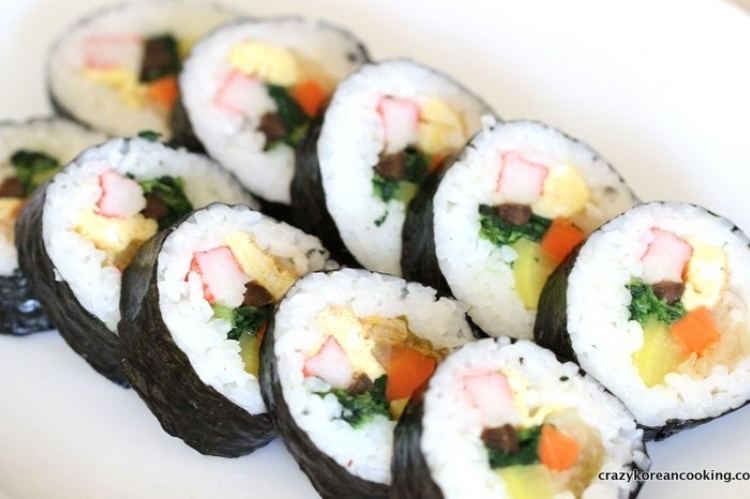
The word gimbap isn't found in Korean language until the modern era, as cooked rice rolled in gim was called bokssam (복쌈; 福-) in the Joseon era (1392–1897).
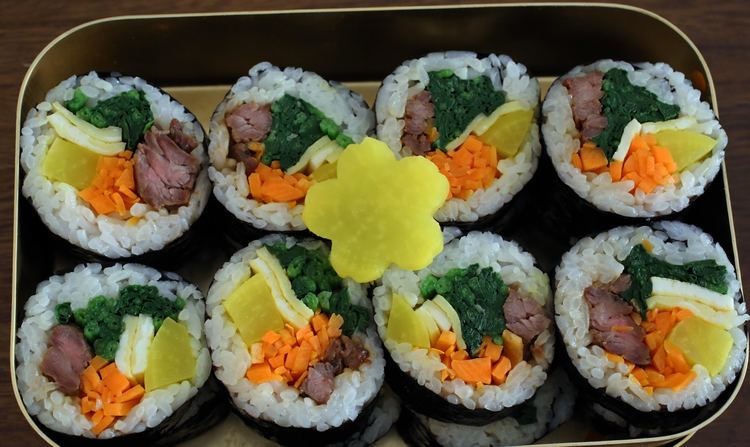
Although the word gimbap is found in a newspaper article from 1935, the loan word norimaki, borrowed from Japanese during the Japanese forced occupation (1910-1945), was used along with gimbap until gimbap was made the universal term, as part of efforts to clear away the remnants of Japanese colonialism and to purify the Korean language.
History
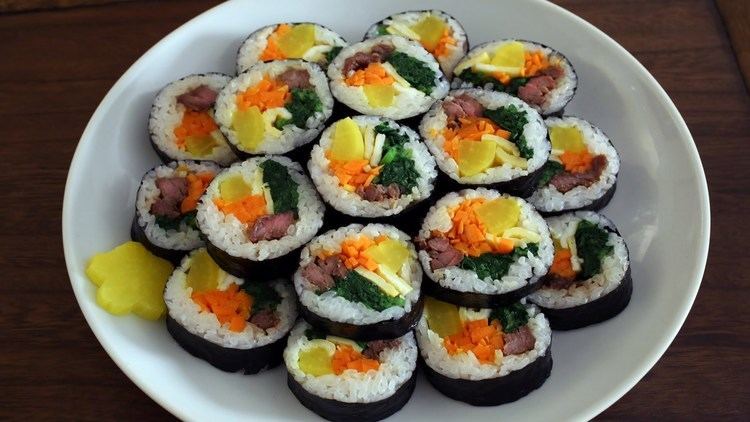
Books from 15th century, such as Gyeongsang-do Jiriji and Sinjeung Dongguk Yeoji Seungnam, report the production of gim (dried sheets of laver seaweed) in Gyeongsang and Jeolla Provinces. Eating cooked rice rolled in gim is also a custom of long standing in Korea. Yeoryang Sesigi, a Joseon book from 1819, describes the dish using the word bokssam (복쌈; transcribe using hanja bakjeom 縛占).
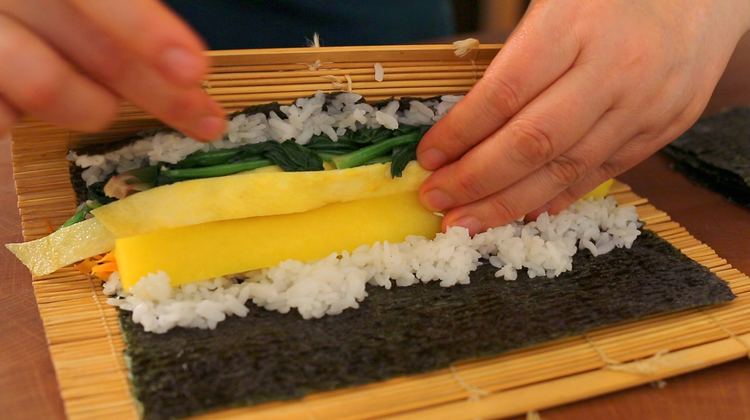
However, there are two different and conflicting versions of the origin of modern form of gimbap. Some sources say it was derived from norimaki, a Japanese sushi variant, introduced to Korea during the Japanese forced occupation (1910-1945). Other sources say the food was developed from the local tradition of rolling bap (cooked rice) and banchan (side dishes) in gim.
Nowadays, gimbap and norimaki are treated as distinct dishes in both Japan and Korea: the former called kinpapu (キンパプ) in Japanese and the latter called gimchobap (김초밥; "gim sushi") or norimaki (노리마키) in Korean. Gimbap usually contains more ingredients and is seasoned with sesame oil, while norimaki is rolled with less ingredients and is seasoned with rice vinegar.
Ingredients
The literal translation of the word gimbap is "seaweed rice". These two things are the most basic components of gimbap. From there, you can find many variations on the filling, including fish, meat, eggs, and vegetables, whether pickled, roasted, or fresh.
Traditionally, the rice is lightly seasoned with salt and sesame oil/perilla oil. Popular protein ingredients are fish cakes, imitation crab meat, eggs and/or seasoned beef rib-eye. Vegetables usually include cucumbers, spinach, carrots and danmuji (pickled daikon). After the gimbap has been rolled and sliced, it is typically served with danmuji.
Variants
Short grain white rice is usually used, although short-grain brown rice, like olive oil on gim, is now becoming more widespread among the health-conscious. Rarely, sweet rice is mixed in gimbap rice.
Nowadays, the rice in gimbap can be many kinds of black rice, boiled rice and cereals etc.
Gim is dried, pressed seaweed made from the edible species, laver. Gim may be roasted and seasoned with oil and salt, roasted but unseasoned, or raw and unseasoned. The oil used for roasting gim is traditionally sesame oil; however, today, corn and canola oils are also commonly used, especially with the pre-seasoned packs of gim sold widely in stores. Olive oil is also becoming more prevalent. For gimbap, the roasted, unseasoned variation is typically used.
Besides the common ingredients listed above, some varieties may include cheese, spicy cooked squid, kimchi, luncheon meat, or spicy tuna. The gim may be brushed with sesame oil or sprinkled with sesame seeds. In a variation, sliced pieces of gimbap may be lightly fried with egg coating.
Samgak gimbap (삼각김밥), similar to Japanese onigiri, is a triangle-shaped gimbap sold in many convenience stores in South Korea. It comes in a large variety of types.
Chungmu gimbap (충무김밥) is a type of gimbap made with only rice as the filler ingredient. Originating from the seaside city of Chungmu, the rolls are thinner and the surface is usually left unseasoned. Chungmu gimbap is traditionally served with side dishes of kolddugi muchim (꼴뚜기 무침), sliced baby octopus marinated and fermented in a spicy red pepper sauce, and radish kimchi (무김치).
Chamchi gimbap (참치김밥) is another commonly found gimbap. It is usually filled with tuna, marinated perilla leaf, and mayonnaise, as well as other ingredients.
Mayak gimbap (마약김밥) is a specialty of Gwangjang Market in Seoul. Mayak translates as "drug", and its name reflects its allegedly addictive flavour that is distinct from other gimbap because of its pairing with a sauce made from soy sauce and mustard.
Restaurant franchises
Many South Korean fast food restaurant franchises specialize in gimbap and noodles. Among the chains are Gimgane (김家네), "Gimbap Heaven" (김밥천국), "Gimbap Land" (김밥나라), Gimbap and Spaghetti (김밥과 스파게티) and so on. These restaurants serve not only gimbap but also numerous other dishes—typically donkkaseu, ramyeon, udong, naengmyeon, bibimbap, stews (kimchi jjigae, doenjang jjigae, sundubu jjigae), and omurice, among others. Recently there are high-quality gimbap franchises like Kim Sunsang Gimbap (김선생 김밥) and Go bong min Gimbap (고봉민 김밥) in Korea.
